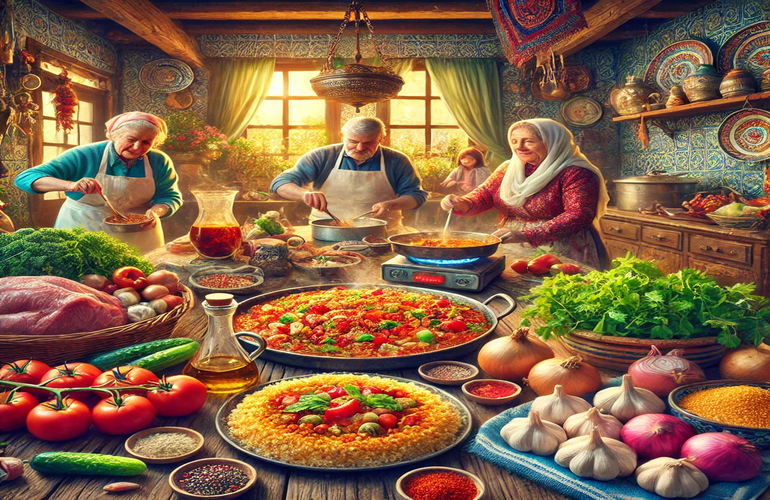
Cevıırı is a traditional Turkish dish that holds a special place in the hearts and kitchens of many. Rich in history and bursting with flavor, this dish showcases the diverse culinary traditions of Turkey. Known for its unique combination of ingredients and meticulous preparation, Cevıırı offers a delightful gastronomic experience. Whether enjoyed at a family gathering or a festive occasion, Cevıırı remains a beloved staple. This guide will take you through its origins, ingredients, preparation methods, and cultural significance, inviting you to explore and savor this exceptional dish.
The Origins and History of Cevıırı
Cevıırı has a rich and storied history that dates back centuries. This traditional Turkish dish has evolved through the ages, influenced by various cultures and regions within the country. The origins of Cevıırı are deeply intertwined with the history of Turkey itself, reflecting the diverse culinary practices that have developed over time.

Historical Background and Evolution
The roots of Cevıırı can be traced back to the nomadic tribes of Central Asia, who brought their culinary traditions to Anatolia. These early influences combined with the local ingredients and cooking methods to create a unique dish. As Turkish culture evolved, so did Cevıırı, incorporating elements from the Ottoman Empire and neighboring regions. This blend of influences has made Cevıırı a symbol of Turkish culinary heritage.
Cultural Context and Traditions
Cevıırı is more than just a dish; it is a representation of Turkish hospitality and community. Traditionally, it is prepared and enjoyed during special occasions, such as festivals, weddings, and family gatherings. The process of making Cevıırı often involves multiple generations, with recipes and techniques passed down through families. This communal aspect of its preparation and consumption highlights its role in bringing people together.
The preparation of Cevıırı varies across different regions of Turkey, each adding its own unique touch. In coastal areas, the dish might feature fresh seafood, while inland regions might use lamb or beef. These regional variations add to the rich tapestry of Cevıırı’s history, showcasing the adaptability and creativity of Turkish cuisine.
Cevıırı’s evolution is also marked by its adaptation to modern tastes and dietary preferences. While traditionally it was a hearty, meat-based dish, contemporary versions may include vegetarian or vegan options. This flexibility ensures that Cevıırı remains relevant and beloved in Turkish kitchens today.
Ingredients of Cevıırı
Cevıırı’s flavor and texture are rooted in its carefully selected ingredients, which contribute to its distinctive taste. The combination of traditional and fresh ingredients ensures an authentic and delightful culinary experience. Here, we explore the essential and optional components that make up this beloved Turkish dish.
Essential Ingredients
- Meat: The primary ingredient in traditional Cevıırı is meat, typically lamb or beef. The quality and cut of the meat are crucial, with preference often given to tender, flavorful cuts. The meat is usually marinated to enhance its taste and tenderness.
- Bulgur Wheat: Bulgur wheat is a staple in many Turkish dishes, including Cevıırı. It adds a unique texture and nutty flavor to the dish. Bulgur is not only a hearty ingredient but also a nutritious one, packed with fiber and essential nutrients.
- Onions and Garlic: These aromatic vegetables are essential for the base of Cevıırı. They are often sautéed to bring out their natural sweetness and depth of flavor.
- Tomatoes and Tomato Paste: Fresh tomatoes and tomato paste contribute to the rich, savory sauce that coats the meat and bulgur. The acidity of the tomatoes balances the richness of the meat, creating a harmonious blend of flavors.
- Spices: A blend of spices is crucial for achieving the authentic taste of Cevıırı. Common spices include cumin, paprika, black pepper, and sometimes a hint of cinnamon or allspice. These spices provide warmth and complexity to the dish.
Optional Additions
- Vegetables: Depending on regional variations and personal preferences, additional vegetables such as bell peppers, eggplants, or carrots can be included. These vegetables add color, flavor, and nutritional value to the dish.
- Herbs: Fresh herbs like parsley, mint, or dill can be added towards the end of cooking or as a garnish. These herbs brighten the dish and add a fresh, aromatic element.
- Legumes: Some versions of Cevıırı incorporate legumes such as chickpeas or lentils, enhancing the dish’s texture and nutritional profile.
- Fruits: In certain regions, dried fruits like apricots or raisins are added to provide a sweet contrast to the savory ingredients. This combination of sweet and savory is a hallmark of many traditional Turkish dishes.
Nutritional Profile and Health Benefits
Cevıırı is not only delicious but also offers several health benefits due to its wholesome ingredients:
- Protein: The meat provides a significant source of protein, essential for muscle repair and overall health.
- Fiber: Bulgur wheat and any included vegetables contribute a good amount of dietary fiber, aiding in digestion and promoting a healthy gut.
- Vitamins and Minerals: Onions, garlic, tomatoes, and herbs are rich in vitamins A, C, and K, as well as minerals like potassium and iron.
- Antioxidants: Spices and herbs used in Cevıırı, such as cumin and parsley, are known for their antioxidant properties, which help protect the body from oxidative stress.
How to Make Cevıırı: Step-by-Step Preparation Guide
Creating Cevıırı at home is an enjoyable and rewarding process. This guide will walk you through the steps to prepare a delicious and authentic dish, from selecting ingredients to serving the final product.
Preparing the Ingredients
- Meat Preparation:
- Choose high-quality lamb or beef.
- Cut the meat into small, bite-sized pieces.
- Marinate the meat with a mix of olive oil, salt, pepper, and a dash of cumin for at least an hour. This helps to tenderize the meat and infuse it with flavor.
- Vegetable Preparation:
- Finely chop onions and garlic.
- Dice fresh tomatoes and set aside tomato paste.
- If using additional vegetables like bell peppers or eggplants, chop them into small, even pieces.
- Bulgur Wheat:
- Rinse the bulgur wheat under cold water and let it soak for about 20 minutes. Drain well before cooking.
Cooking Instructions
- Sautéing the Base:
- Heat a generous amount of olive oil in a large, heavy-bottomed pot.
- Add the chopped onions and garlic, sautéing until they become translucent and fragrant.
- Adding the Meat:
- Add the marinated meat to the pot.
- Brown the meat on all sides, which helps to lock in the flavors and juices.
- Building the Sauce:
- Stir in the diced tomatoes and tomato paste.
- Cook the mixture until the tomatoes break down and create a rich, thick sauce.
- Incorporating Spices:
- Season the mixture with cumin, paprika, black pepper, and a pinch of cinnamon or allspice if desired.
- Stir well to distribute the spices evenly.
- Adding Bulgur Wheat:
- Mix the soaked and drained bulgur wheat into the pot.
- Pour in enough water or broth to cover the ingredients. Bring the mixture to a boil, then reduce the heat to low.
- Simmering:
- Cover the pot and let the dish simmer for about 30-40 minutes.
- Stir occasionally and check the liquid levels, adding more water or broth if necessary.
- The dish is ready when the bulgur wheat is tender, and the flavors are well combined.
Serving Suggestions
- Plating:
- Serve Cevıırı hot, straight from the pot.
- Garnish with fresh herbs like parsley or mint for a burst of color and freshness.
- Accompaniments:
- Pair the dish with a side of plain yogurt or a fresh salad to balance the rich flavors.
- Warm flatbreads or pita are perfect for scooping up the savory mixture.
- Presentation:
- For a traditional touch, serve Cevıırı in a large, communal dish, allowing everyone to partake from the same bowl.
- Alternatively, plate individual servings for a more modern presentation.
Regional and Global Variations of Cevıırı
Cevıırı, while deeply rooted in Turkish culinary traditions, has seen numerous adaptations and variations both within Turkey and around the world. Each region brings its own unique flavors and ingredients to the dish, showcasing the versatility and widespread appeal of Cevıırı.

Regional Variations Within Turkey
- Coastal Influence:
- In coastal areas, such as the Aegean and Mediterranean regions, Cevıırı often incorporates seafood. Fresh fish or shrimp replace the traditional lamb or beef, giving the dish a lighter, more oceanic flavor profile.
- Local herbs like oregano and basil are frequently used, adding a distinctive aroma that reflects the coastal environment.
- Central Anatolia:
- The heartland of Turkey, Central Anatolia, prefers a heartier version of Cevıırı. Lamb is the primary meat, often combined with rich tomato-based sauces and spices like cumin and paprika.
- This region might also include dried fruits such as apricots or raisins, offering a sweet contrast to the savory meat and spices.
- Southeastern Turkey:
- Southeastern Turkey is known for its bold and spicy cuisine, and Cevıırı from this region is no exception. It often features hot peppers, garlic, and a liberal use of spices such as sumac and red pepper flakes.
- The inclusion of ingredients like pomegranate molasses can add a tangy and slightly sweet note, enhancing the complexity of the dish.
International Interpretations and Recipes
- Latin American Influence:
- In Latin America, particularly in countries like Peru and Mexico, the concept of Cevıırı has been adapted to local tastes. These versions might include ingredients like corn, beans, and avocados.
- The use of lime juice and cilantro is common, giving the dish a fresh and zesty flavor that is distinct from its Turkish origins.
- Middle Eastern Adaptations:
- Middle Eastern variations of Cevıırı often incorporate elements from neighboring cuisines. For example, ingredients such as chickpeas, tahini, and yogurt are frequently added.
- Spices like cardamom, cinnamon, and allspice provide a warm, aromatic quality, reflecting the region’s rich culinary heritage.
- Mediterranean Touch:
- In the broader Mediterranean region, Cevıırı is sometimes adapted to include olives, feta cheese, and sun-dried tomatoes. These ingredients complement the traditional base of meat and bulgur, adding layers of flavor and texture.
- Fresh herbs like rosemary and thyme are used, bringing a fragrant Mediterranean essence to the dish.
Modern Variations and Dietary Adaptations
- Vegetarian and Vegan Options:
- Modern dietary trends have led to the creation of vegetarian and vegan versions of Cevıırı. These adaptations often use legumes like lentils or chickpeas as a protein source, combined with an array of vegetables.
- Tofu or tempeh might replace meat, and vegetable broth substitutes for the traditional meat-based stock, maintaining the dish’s richness and depth of flavor.
- Gluten-Free Alternatives:
- For those avoiding gluten, bulgur wheat can be substituted with gluten-free grains such as quinoa or rice. These grains provide a similar texture and absorb the dish’s flavors well.
- Adjusting the spices and cooking methods allows for a gluten-free version that retains the essence of traditional Cevıırı.
- Fusion Recipes:
- Chefs and home cooks worldwide experiment with fusion recipes, blending Cevıırı with elements from other cuisines. For example, incorporating Asian ingredients like soy sauce and ginger can create a unique fusion dish.
- These innovative approaches not only preserve the core characteristics of Cevıırı but also introduce exciting new flavors and combinations.
Cevıırı in Turkish Cuisine
Cevıırı occupies a special place in Turkish cuisine, reflecting the country’s rich culinary heritage and diverse regional flavors. This section explores its cultural significance, traditional recipes, and its role in various Turkish meals.
Role in Turkish Cultural Traditions
Cevıırı is deeply embedded in Turkish cultural traditions, often associated with celebrations, family gatherings, and communal events. It symbolizes hospitality and generosity, frequently prepared for guests and special occasions. The dish brings people together, reinforcing social bonds and cultural continuity.
- Festive Occasions:
- Cevıırı is a popular choice for festivals and holidays, showcasing the host’s culinary skills and hospitality. It is often prepared in large quantities to serve a crowd, highlighting its communal nature.
- Family Gatherings:
- During family gatherings, Cevıırı serves as a centerpiece, bringing generations together. Recipes and cooking techniques are passed down, preserving family traditions and culinary heritage.
Popular Turkish Dishes Featuring Cevıırı
Cevıırı is versatile and appears in various forms across Turkish cuisine. Its adaptability allows it to be incorporated into numerous traditional dishes, each with its own regional twist.
- Stuffed Vegetables (Dolma):
- In some regions, Cevıırı is used as a stuffing for vegetables like peppers, zucchini, and eggplants. The bulgur-based stuffing, mixed with meat and spices, adds a hearty and flavorful component to these dishes.
- Casseroles and Stews:
- Cevıırı can be found in Turkish casseroles and stews, combined with ingredients such as tomatoes, peppers, and a mix of spices. These dishes are slow-cooked, allowing the flavors to meld beautifully.
- Pilaf Variations:
- A popular variation is the Cevıırı pilaf, where bulgur wheat is cooked with onions, tomatoes, and various herbs. This dish is a staple in many Turkish households, often served alongside grilled meats or vegetables.
Culinary Techniques and Preparation
The preparation of Cevıırı involves specific culinary techniques that contribute to its unique flavor and texture. These methods have been refined over centuries, reflecting the expertise of Turkish cooks.
- Marination:
- Marinating the meat is a crucial step, infusing it with flavors and tenderizing it. Traditional marinades include olive oil, garlic, and a blend of spices like cumin and paprika.
- Sautéing:
- Sautéing onions and garlic in olive oil forms the aromatic base of Cevıırı. This step enhances the dish’s depth of flavor and sets the stage for adding other ingredients.
- Simmering:
- The simmering process allows the bulgur wheat and meat to absorb the spices and liquids fully. This slow cooking method ensures a rich and cohesive taste.
Nutritional and Dietary Considerations
Cevıırı is not only flavorful but also nutritious, making it a balanced addition to the diet. Its ingredients provide a variety of health benefits, contributing to overall well-being.
- Rich in Protein:
- The meat component supplies essential proteins, supporting muscle repair and growth. This makes Cevıırı a substantial meal, suitable for various dietary needs.
- High in Fiber:
- Bulgur wheat is a good source of dietary fiber, aiding digestion and promoting a healthy gut. It also helps in maintaining steady blood sugar levels.
- Packed with Vitamins and Minerals:
- Vegetables and spices used in Cevıırı offer a range of vitamins and minerals, including vitamins A, C, and K, and minerals like potassium and iron. These nutrients are vital for maintaining good health.
Modern Adaptations
While Cevıırı retains its traditional roots, it has also adapted to modern culinary trends. Chefs and home cooks experiment with new ingredients and techniques, keeping the dish relevant and exciting.
- Vegetarian and Vegan Versions:
- Modern adaptations include vegetarian and vegan versions, where legumes and vegetables replace the meat. These variations cater to diverse dietary preferences while maintaining the dish’s integrity.
- Fusion Recipes:
- Fusion recipes blend Cevıırı with elements from other cuisines, creating innovative dishes that appeal to contemporary palates. These experiments demonstrate the dish’s versatility and enduring popularity.
Top Places to Enjoy Cevıırı in Turkey and Beyond
Experiencing Cevıırı at its best often means seeking out the places where it is most authentically prepared and celebrated. Turkey offers a wealth of locations, from bustling cities to serene coastal towns, where Cevıırı is a highlight on many menus. Beyond Turkey, this dish has also found a place in various international cuisines, adapted to local tastes while retaining its essential character.

Renowned Restaurants in Turkey
- Aheste (Istanbul)
- Located in Istanbul’s trendy Karaköy district, Aheste is known for its contemporary take on traditional Turkish dishes. The restaurant serves a sophisticated version of Cevıırı, combining high-quality ingredients with innovative presentation. The ambiance of Aheste, with its modern decor and intimate setting, enhances the dining experience.
- Karaköy Lokantasi (Istanbul)
- This classic eatery in Istanbul offers a more traditional approach to Turkish cuisine. Karaköy Lokantasi is famous for its dedication to preserving the authentic flavors of regional dishes. Their Cevıırı stays true to its roots, prepared with locally sourced ingredients and served in a charming, vintage-inspired setting.
- Mürver (Istanbul)
- With a focus on wood-fired cooking, Mürver provides a unique twist on Cevıırı. The restaurant’s location, offering stunning views of the Bosphorus, pairs perfectly with its innovative menu. Mürver’s Cevıırı features a smoky flavor, achieved through the use of open flames and carefully selected spices.
- Haci Abdullah Lokantasi (Istanbul)
- Established in 1888, Haci Abdullah Lokantasi is a historic restaurant in Istanbul renowned for its traditional Turkish cuisine. Their Cevıırı is a testament to time-honored recipes, providing a nostalgic culinary experience that transports diners to a bygone era.
Regional Highlights
- Ankara
- As the capital of Turkey, Ankara boasts several restaurants where Cevıırı is a staple. Places like Trilye offer an upscale dining experience with a focus on seafood variations of the dish, reflecting the city’s diverse culinary landscape.
- Antalya
- Known for its stunning coastline, Antalya features many restaurants that incorporate fresh seafood into their Cevıırı recipes. The coastal influence is evident in places like Seraser Fine Dining Restaurant, where the dish is prepared with local fish and Mediterranean herbs.
- Gaziantep
- This southeastern city is a UNESCO-recognized center of gastronomy, celebrated for its rich culinary heritage. Restaurants such as Imam Cagdas are famous for their robust, flavorful Cevıırı, showcasing the spicy and aromatic profile typical of the region.
Cevıırı Tourism and Cultural Experiences
- Food Festivals
- Turkey hosts numerous food festivals where Cevıırı features prominently. Events like the Istanbul Food Festival and the Bodrum Food and Culture Festival provide opportunities to taste different versions of the dish, prepared by renowned chefs and local artisans.
- Cooking Classes
- For those interested in learning to prepare Cevıırı themselves, cooking classes are available throughout Turkey. These classes, often held in cities like Istanbul and Izmir, offer hands-on experience in making traditional Turkish dishes under the guidance of experienced chefs.
- Market Tours
- Visiting local markets, such as the Grand Bazaar in Istanbul or the Kemeraltı Market in Izmir, can also enhance the Cevıırı experience. These markets offer the freshest ingredients and spices, providing insights into the components that make up this beloved dish.
International Enjoyment
- Turkish Restaurants Abroad
- Cevıırı has crossed borders and can be found in Turkish restaurants around the world. Cities like New York, London, and Berlin have vibrant Turkish communities where authentic Cevıırı is served. Restaurants like Le Bab in London and Sofra in New York are notable for their dedication to quality and tradition.
- Fusion Restaurants
- Some international restaurants experiment with Cevıırı, blending it with local cuisines to create fusion dishes. These adaptations, while maintaining the core elements of the dish, introduce new flavors and techniques, offering a fresh perspective on a traditional favorite.
Conclusion
Cevıırı represents a rich tapestry of Turkish culinary tradition, bringing together historical roots, diverse regional flavors, and modern adaptations. Its significance extends beyond mere sustenance, symbolizing community, hospitality, and cultural heritage. From bustling Istanbul restaurants to serene coastal eateries, and even in global kitchens, Cevıırı continues to be celebrated and cherished. Whether enjoyed in its traditional form or as a contemporary twist, this beloved dish invites everyone to experience the unique flavors and warmth of Turkish cuisine.
FAQs
1. What is Cevıırı?
Cevıırı is a traditional Turkish dish made primarily with meat, bulgur wheat, and a variety of spices and vegetables. It is known for its rich flavor and cultural significance in Turkish cuisine.
2. How is Cevıırı typically prepared?
The dish involves marinating meat, sautéing onions and garlic, adding spices and tomatoes, then mixing in bulgur wheat and simmering until fully cooked. Variations may include additional vegetables or regional ingredients.
3. Are there vegetarian versions of Cevıırı?
Yes, vegetarian and vegan versions of Cevıırı exist, often using legumes like lentils or chickpeas and a mix of vegetables to replace the meat, while maintaining the dish’s flavorful profile.
4. Where can I find authentic Cevıırı in Turkey?
Authentic Cevıırı can be found in many Turkish cities, with renowned restaurants such as Aheste and Karaköy Lokantasi in Istanbul, as well as local eateries in Ankara, Antalya, and Gaziantep offering excellent versions of the dish.
5. Can I make Cevıırı at home, and what ingredients do I need?
Yes, Cevıırı can be made at home. Essential ingredients include lamb or beef, bulgur wheat, onions, garlic, tomatoes, tomato paste, and a blend of spices like cumin and paprika. Optional additions can include various vegetables and herbs for extra flavor.









